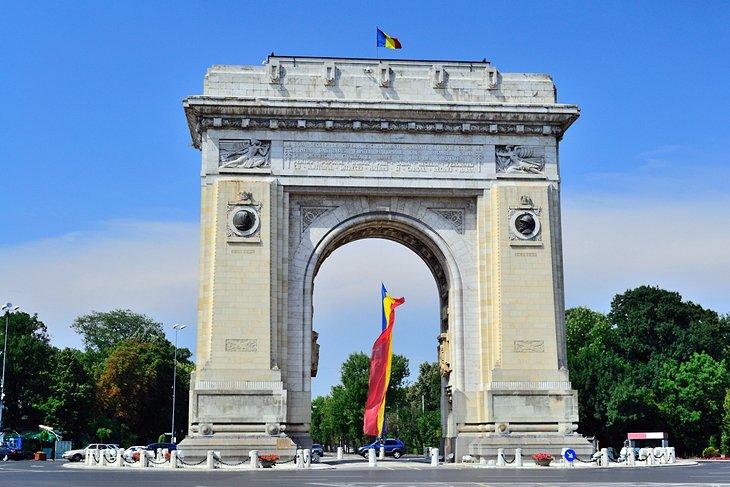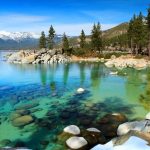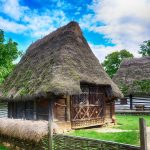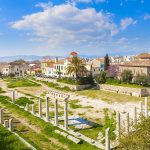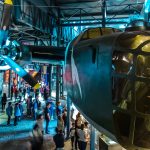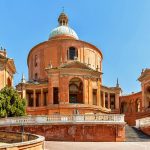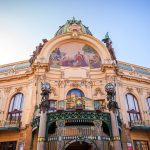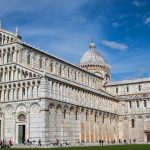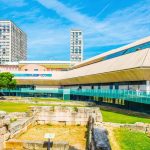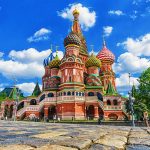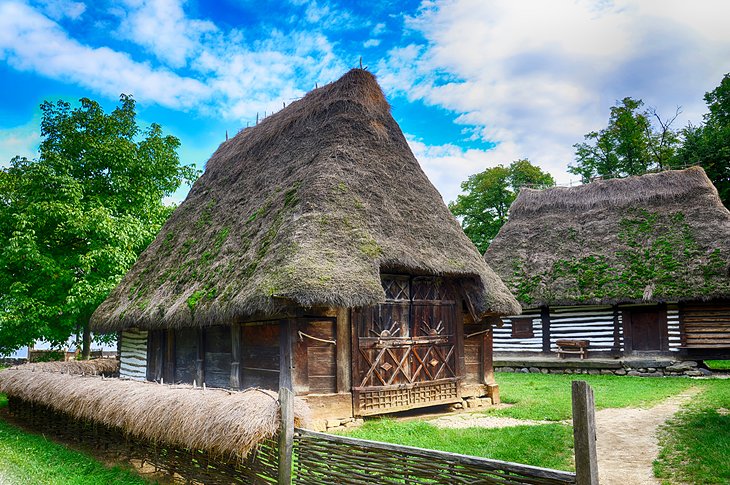
Bucharest tourist attractions
Bucharest is the capital and largest city of Romania. It is described as the cultural, financial, entertainment, and media centre in the country with a significant influence in Eastern Europe as well. In geopolitical regards, Bucharest has been and still is an important capital of a state situated in Central and Eastern Europe, where noteworthy summits had taken place (for example the 2008 Bucharest summit). It is also a city with a significant influence in terms of education, tourism, research, technology, health care, art, fashion, sports, and politics. Bucharest is a major economic center in Romania, with a diverse and growing economy that includes industries such as IT, finance, and manufacturing. The city has also seen significant investment in infrastructure, with new roads, bridges, and public transportation systems being built to improve connectivity and mobility. It is located in the south-east of Romania, on the banks of the Dâmbovița river, less than 60 km (37.3 mi) north of the Danube River and the border with Bulgaria. It is also one of the most populated cities of the European Union (EU) within city limits and the most populated capital in Eastern Europe. It was the capital of Wallachia from 1659 to 1859 and the capital of the United Principalities of Moldavia and Wallachia (Romanian United Principalities, later the Kingdom of Romania) from 1859 to 1881.
1.Palace of the Parliament
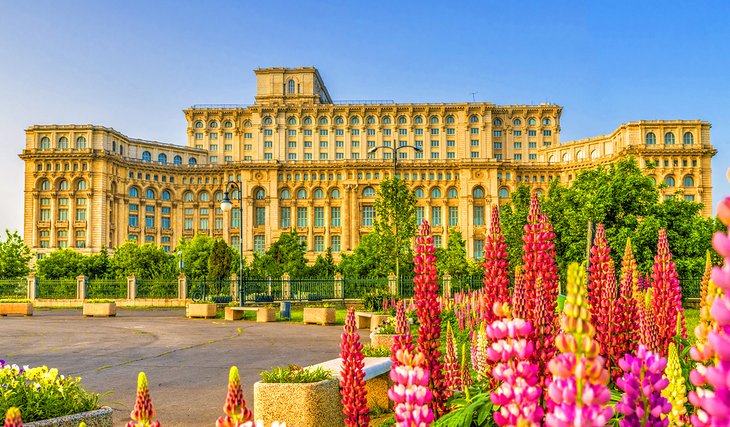
The Palace of the Parliament (Romanian: Palatul Parlamentului), also known as the House of the Republic or People’s House/People’s Palace , is the seat of the Parliament of Romania, located atop Dealul Spirii in Bucharest, the national capital. The Palace reaches a height of 84 m (276 ft), has a floor area of 365,000 m2 (3,930,000 sq ft) and a volume of 2,550,000 m3 (90,000,000 cu ft). The Palace of the Parliament is one of the heaviest buildings in the world, weighing about 4,098,500,000 kilograms (9.04 billion pounds; 4.10 million tonnes), also being the second largest administrative building in the world. (The Great Pyramid of Giza at about 5.75 million tons is about 40% heavier.) The building was designed and supervised by chief architect Anca Petrescu, with a team of approximately 700 architects, and constructed over a period of 13 years (1984–97) in modernist Neoclassical architectural forms and styles, with socialist realism in mind. The Palace was ordered by Nicolae Ceaușescu (1918–1989), the president of Communist Romania and the second of two long-ruling heads of state in the country since World War II, during a period in which the personality cult of political worship and adoration increased considerably for him and his family.
The Palace of the Parliament (Palatul Parlamentului) is one of the top tourist attractions in Bucharest. It is the world’s second-largest administrative building (after the Pentagon), an architectural colossus that also claims the title as the heaviest building in the world.
Boasting more than 3,000 rooms over 330,000 square meters and constructed with marble and steel, it was originally called the People’s House by its visionary, the dictator Nicolae Ceausescu, who used it as his family’s residence and as the seat of his government.
To complete it, Ceausescu razed places of worship, workshops, factories, parks, part of the Old Town, and entire neighborhoods. More than 20,000 workers and 700 architects worked on the opulent Neoclassical-style palace over a span of 13 years, from 1985 to 1997, during which time the majority of Romanians faced poverty.
2.Romanian Athenaeum
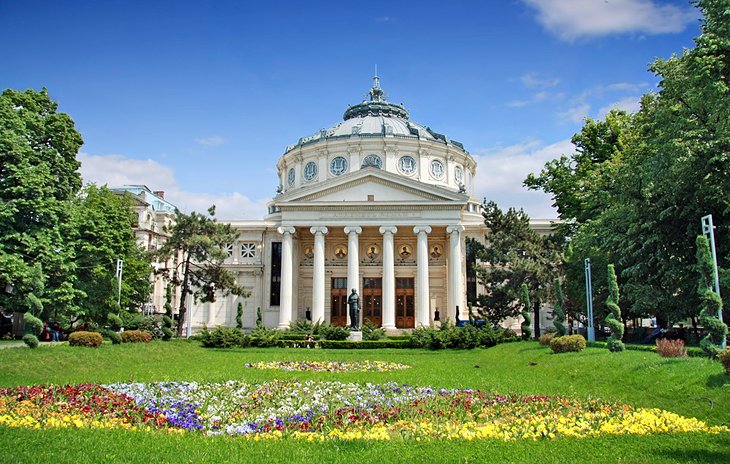
The Romanian Athenaeum (Romanian: Ateneul Român) is a concert hall in the center of Bucharest, Romania, and a landmark of the Romanian capital city. Opened in 1888, the ornate, domed, circular building is the city’s most prestigious concert hall and home of the “George Enescu” Philharmonic and of the George Enescu Festival.
. The 19th-century building, designed by French architect Albert Galleron, resembles an ancient Greek temple with a 41-meter-high dome and a peristyle of six Ionic columns.
The interiors feature a lobby of intricately painted gold-leaf ceilings, cascading balconies, and spiral marbled staircases. The 652-seat auditorium is known for its excellent acoustics and its fine art. A 70-meter-long and three-meter-high fresco that winds its way around the circular hall proudly depicts scenes from Romania’s history.
In 1865, cultural and scientific personalities such as Constantin Esarcu, V. A. Urechia, and Nicolae Creţulescu founded the Romanian Athenaeum Cultural Society. To serve its purposes, the Romanian Athenaeum, a building dedicated to art and science, would be erected in Bucharest.
The building was designed by the French architect Albert Galleron, built on a property that had belonged to the Văcărescu family and inaugurated in 1888, although work continued until 1897. A portion of the construction funds was raised by public subscription in a 28-year-long effort, of which the slogan is still remembered today: “Donate one leu for the Ateneu!”
3.Stavropoleos Church
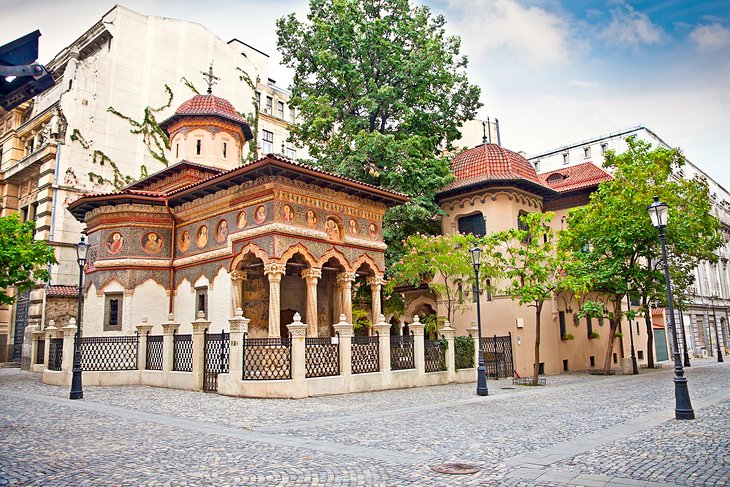
Stavropoleos Monastery (Romanian: Mănăstirea Stavropoleos), also known as Stavropoleos Church (Romanian: Biserica Stavropoleos) during the last century when the monastery was dissolved, is an Eastern Orthodox monastery for nuns in central Bucharest, Romania. Its church is built in Brâncovenesc style. The patrons of the church (the saints to whom the church is dedicated) are St. Archangels Michael and Gabriel. The name Stavropoleos is the genitive case of Stavropolis (Greek, “The city of the Cross”). One of the monastery’s constant interests is Byzantine music, expressed through its choir and the largest collection of Byzantine music books in Romania.
Tiny, peaceful, and beautiful, the Stavropoleos Church (Manastirea Stavropoleos) was built in 1724 by a Greek monk, Ioanikie Stratonikeas. With its intricately carved entrance lined with columns, this Brâncovenesc-style church stands apart as a unique landmark in Bucharest.
The Orthodox church features fine stone and wood carvings and a combination of Romanian and Byzantine elements. It is surrounded by a garden courtyard filled with 18th-century tombstones.
Inside, several frescoes and wood icons can be admired. The church complex once included an inn and a monastery but both were destroyed. The church itself was restored several times after damage from earthquakes, and is noted for its unique library that houses a large collection of books related to Byzantine music.
4.Revolution Square
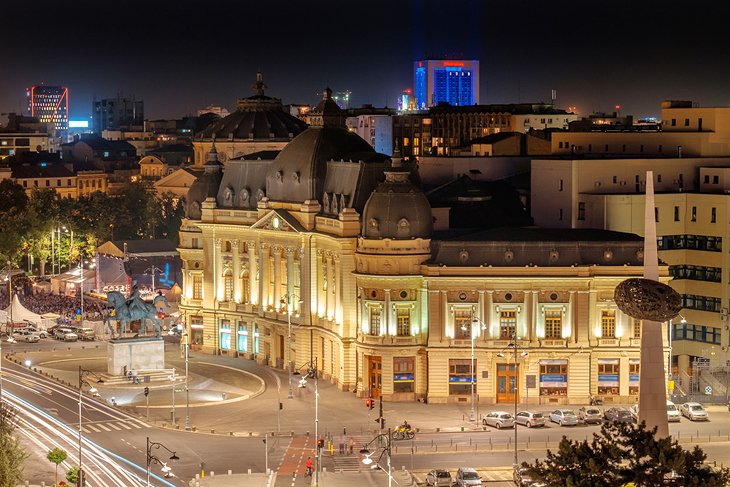
Plaza de la Revolución (Spanish pronunciation: [ˈplasa ðe la reβoluˈsjon]), “Revolution Square”, is a municipality (or borough) and a square in Havana, Cuba.
The municipality, one of the 15 forming the city, stretches from the square down to the sea at the Malecón and includes the Vedado district.
Revolution Square (Piata Revolutiei) earned its name after setting the scene of dictator Nicolae Ceausescu’s final minutes of power in Romania. On December 21, 1989, a coup d’état ensued here with the help of a crowd of more than 100,000, forcing the leader of the communist party to flee and changing the course of the country’s history.
Until that date, the central square was known as Palace Square, due to its proximity to the Royal Palace, which is the current home to the National Museum of Art.
5.Arcul de Triumf
Arcul de Triumf este un monument situat în partea de nord a Bucureștiului, în sectorul 1, la intersecția șoselei Kiseleff cu bulevardele Constantin Prezan, Alexandru Averescu și Alexandru Constantinescu. Monumentul, proiectat de Petre Antonescu, a fost construit în perioada 1921-1922, renovat în perioada 1935-1936, și din nou renovat începând din 2014. El comemorează participarea României în Primul Război Mondial.
Arcul de Triumf are 27 m înălțime, cu o singură deschidere și este de formă paralelipipedică. Machetele au fost executate de artiști plastici, iar pentru cioplirea marmurei de Rușchița, pe lângă sculptorii autohtoni, s-a apelat și la un număr de zece sculptori din Italia.
Finished in 1878, Bucharest’s first Arch of Triumph (Arcul de Triumf) was made from wood and dedicated to the Romanian soldiers who fought in World War I. In 1936, it was reconstructed in granite and designed by architect Petre Antonescu at a height of 27 meters. The arch is adorned with sculptures created by the most notable Romanian sculptors, including Ion Jalea and Dimitrie Paciurea.
To this day it continues to serve its purpose of being the central point for military parades. Romanian soldiers march beneath it for big events, including each December 1st, which is the country’s national holiday.
6.National Museum of Art of Romania
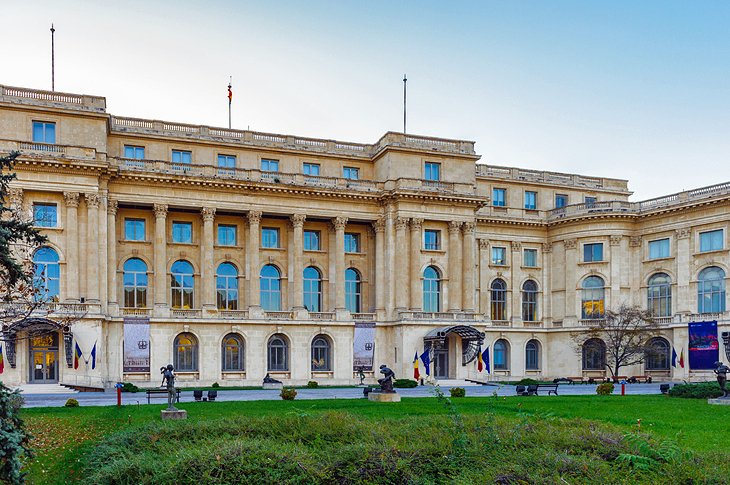
The National Museum of Art of Romania (Romanian: Muzeul Național de Artă al României) is located in the Royal Palace in Revolution Square, central Bucharest. It features collections of medieval and modern Romanian art, as well as the international collection assembled by the Romanian royal family.
The exhibition “Shadows and Light” ran from 15 July to 2 October 2005. With four centuries of French art, it was the largest exhibition of French painting in Central and Eastern Europe since 1945. 77 works were exhibited, including masterpieces by painters such as Poussin, Chardin, Ingres, David, Delacroix, Corot, Cézanne, Matisse, Picasso, and Braque.
Housed in the former Royal Palace, the National Museum of Art of Romania (Muzeul National de Arta al României) is the country’s leading art museum and houses the world’s most complete collection of Romanian art, including medieval and modern art.
Established in 1948, the museum is also where the Royal Collection, including Romanian and European art dating back to the 15th century, can be admired. More than 100,000 works are in the various halls, including paintings by the country’s most celebrated artists, Theodor Aman, Nicolae Grigorescu, and Gheorghe Tattarescu.
7.Dimitrie Gusti National Village Museum

The Village Museum or formally National Museum of the Village “Dimitrie Gusti” (Romanian: Muzeul Național al Satului “Dimitrie Gusti”) is an open-air ethnographic museum located in the King Michael I Park, Bucharest, Romania. The museum showcases traditional Romanian village life. The museum extends to over 100,000 m2,and contains 123 authentic peasant settlements, 363 monuments and over 50,000 artefacts from around Romania Structures in the museum ranged from the 17th to the 20th century, representative of different ethnographic regions including Banat, Transylvania, Moldavia, Maramures, Oltenia, Dobrogea, Muntenia
Founded in 1936, the Dimitrie Gusti National Village Museum – usually shortened to simply the “Village Museum” (Muzeul Satului) – is a unique open-air
museum that stretches through leafy Herastrau Park and depicts the traditional way of life in Romania.
Visitors can wander through 300 traditional buildings, including peasant homes with steep roofs, thatched barns, heavy log cabins, various types of churches, workshops, and mills – all of which have been transported from towns across every region of Romania.
